The Book of Judith is about a fabulously wealthy widow, who delivers a city out of the hands of King Nebuchadnezzar's Army, by a cunning ploy, while remaining faithful to her God.
Mr Wilson's play, The Judith Code, is not set in Old Testament times, however.
It is set in the present-day, just as a new wave of terrorism has struck America and the West.
Visit PaleoJudaica daily for the latest news on ancient Judaism and the biblical world.
E-mail: paleojudaica-at-talktalk-dot-net ("-at-" = "@", "-dot-" = ".")
Saturday, October 07, 2006
THE JUDITH CODE?
THE DISCOVERING THE DEAD SEA SCROLLS EXHIBIT in Seattle is reviewed in the Oregonian:
THE DEAD SEA SCROLLS IN SEATTLEThe postage-stamp comparison is pretty good, but all the scrolls have been published now, unless you're counting bits with only a letter or two on them. Also, I'm not sure I would describe any of the Dead Sea Scrolls as "secular" and I think it's anachronistic to describe the Yahad as "what might have been the first kibbutz." I could nit-pick some more, but the article does have some useful information for beginners.
Saturday, October 07, 2006
NANCY HAUGHT
SEATTLE -- Next time you stick a postage stamp on an envelope, think of the Dead Sea Scrolls. Why? Because many of the thousands of scroll fragments discovered in 11 Judean caves between 1947 and 1956 are about the size of a 39-cent stamp. Which helps explain why they haven't all been published -- and why the display of scroll fragments at Seattle's Pacific Science Center is so absorbing.
There are lots of reasons to make the trip to see "Discovering the Dead Sea Scrolls" before it closes Jan. 7. The joint effort of the Pacific Science Center and the Discovery Place in Charlotte, N.C., is a rare opportunity to see scrolls that have never been exhibited before, to lay eyes on the oldest biblical manuscripts recovered to date, and to learn what they can teach us about history, culture and human life outside of religion.
It's also an opportunity to see how cutting-edge science, which often promises to take us far into the future, can also take us back into the past.
[...]
Friday, October 06, 2006
JON LEVENSON'S NEW BOOK ON RESURRECTION is reviewed in the New York Times:
(Via the Agade list.)
The Case for What ‘Comes as a Shock to Most Jews and Christians Alike’It is not clear to me from this review what exactly Professor Levenson is arguing, but it sounds like an interesting book.
By PETER STEINFELS
Published: September 30, 2006
Correction Appended
In classical Judaism, resurrection of the dead was a central belief, essential to defining oneself as a Jew. “Today,” writes Jon D. Levenson, professor of Jewish studies at Harvard, that fact “comes as a shock to most Jews and Christians alike.”
Apart from the Orthodox minority, most Jews, including those who acknowledge belief in the resurrection as a part of Judaism’s historical legacy, seem to rush by the idea as quickly as possible, rendering it perhaps as a metaphor for how one’s good works live on, but in any case ushering it to the margins of their tradition, a minor and dispensable theme in a Judaism that focuses on life.
Resurrection of the dead, it is argued, is a Johnny-come-lately notion, not found in the ancient texts of the Hebrew Bible, which treated mortality matter-of-factly. Instead, the doctrine was an innovation of the Maccabean period, found in the Book of Daniel, written between 167 and 164 B.C.E, when faithful Jews were being persecuted by the Hellenistic monarch Antiochus IV. With ideas borrowed from Zoroastrianism and other foreign sources, resurrection solved the puzzle of understanding divine justice when fidelity to the Law brought about not prosperity and length of years but martyrdom.
Professor Levenson’s new book, “Resurrection and the Restoration of Israel: The Ultimate Victory of the God of Life” (Yale University Press), is a frontal challenge to this account. But the reasons that it has become a staple of modern Jewish apologetics, he allows, “are not hard to find.”
On the one hand, the rejection or marginalization of resurrection offered a clear distinction between Judaism and a Christianity that celebrated the Resurrection of Jesus as the ground for human hope. On the other hand, it simultaneously aligned Judaism with the naturalistic and scientific outlook of modernity “of the sort that dismisses resurrection as an embarrassing relic of the childhood of humanity.”
Professor Levenson does not deny that an unambiguous belief in resurrection of the dead makes a late appearance in Judaism, or that some groups, like the Sadducees, mentioned in the Gospels and by the historian Josephus, never accepted it.
He argues, however, that this late appearance was “both an innovation and a restatement of a tension that had pervaded the religion of Israel from the beginning.” The full-fledged doctrine of resurrection was not primarily a response to the needs of the moment or the challenge of martyrdom. It flowed from “deeper and long-established currents in the religion of Israel.”
[...]
(Via the Agade list.)
SUKKOT (the festival of Booths or Tabernacles) begins this evening at sundown. Best wishes to all those celebrating.
Thursday, October 05, 2006
THE CLEANUP OF BYBLOS is set to begin soon and needs to be completed before winter in order to avoid permanent harm to the site:
Cleanup to Start at Old Sites in Lebanon
By ZEINA KARAM, Associated Press Writer
2:00 PM PDT, October 4, 2006
BYBLOS, Lebanon -- Cleanup is set to begin within days at the first of three ancient World Heritage sites damaged in the summer's Hezbollah-Israel war -- a crumbling old castle rising from the Mediterranean whose foundation stones are now coated with oil sludge.
Tens of thousands of dollars from European and other donors will go toward repairing the damage at the three sites -- first at this ancient Phoenician port city whose history stretches back 7,000 years, then to Roman ruins at Baalbek and Roman-era frescos in Tyre.
But officials say they also worry that many other historic sites, such as old souks, or markets, not listed by UNESCO as World Heritage sites, also were damaged and are getting less attention.
[...]
Wednesday, October 04, 2006
ST. ANDREWS NEW TESTAMENT JOB: Those on the academic job market very likely have already seen this elsewhere, but just in case, here is an advert for a New Testament position at the University of St. Andrews. If you have specific questions, you are welcome to e-mail me or Markus Bockmuehl. Otherwise, just contact Human Resources for the application materials.
Lectureship in New Testament
School of Divinity
University of St Andrews
Salary: £33,101 - £40,711 pa
We are seeking applicants committed to excellence in teaching and research in New Testament. You will contribute to the School's existing strengths in philological and historical scholarship, whilst also having a demonstrable commitment to the interface between biblical studies and Christian theology.
Specialism within the canon of the New Testament is open. You will be expected to teach students from undergraduate to doctoral level and experience of teaching New Testament and Greek is desirable.
While applications are welcome from junior scholars, you will be expected to hold a PhD when you take up the position and will need to demonstrate a capacity and commitment to research and publication as well as teaching.
This is a standard (permanent) appointment similar to an assistant or associate professorship in North America and is available from 1 September 2007, or as soon as possible thereafter.
Informal enquiries to Dr Jim Davila (Tel. +44-1334-462834; email: jrd4@st-andrews.ac.uk) or Prof Markus Bockmuehl (Tel. +44-1334-462831; email: mb101@st-andrews.ac.uk). Further information about the School of Divinity can be found at: http://www.st-andrews.ac.uk/divinity.
Salary subject to confirmation under the new framework agreement.
Please quote ref: SK044/06
Closing Date: 15 December 2006
Application forms and further particulars are available from Human Resources, University of St Andrews, College Gate, North Street, St Andrews, Fife KY16 9AJ, (tel: 01334 462571, by fax 01334 462570 or by e-mail Jobline@st-andrews.ac.uk. The advertisement and further particulars can be viewed at http://www.st-andrews.ac.uk/hr/recruitment/vacancies. The University is committed to equality of opportunity.
THE GARDEN TOMB is profiled in Ynet News's Travel column:
The Garden Tomb – Secret of the missing tombFor more photos and some commentary, see the Garden Tomb entry at BiblePlaces.com.
Many have flocked to Jerusalem in search of Christ's exact place of crucifixion and burial. Upon envisioning a skull, General Gordon declared Christ to be buried in a garden near the Nablus Gate. True or not, it is an enchanting, inspirational English garden
Tuesday, October 03, 2006
HERE ARE SOME NOTES ON THE OTTAWA CHRISTIAN APOCRYPHA WORKSHOP. Photos too. There were many excellent papers. I found these two especially interesting and their authors have kindly given me permission to post their abstracts. [UPDATE (6 October): I now have permission to post a third.]
Here are a few of the many photographs I took. You can click on any of them to get a larger image.

Candid group photo taken on Saturday. The waiter pushed the button prematurely and also had his finger on the lens. Sorry everyone, but the other two were even worse. The baby in the front row is Katerina, daughter of Cornelia Horn and Rob Phenix. She was the quietest, most contemplative baby I've ever met.
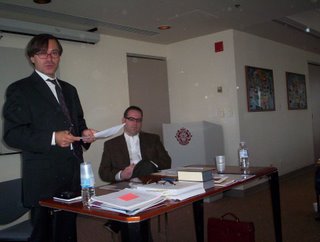
Pierluigi Piovanelli (l) and Lorenzo DiTommaso (r) in the opening session.

Michael Kaler presents.
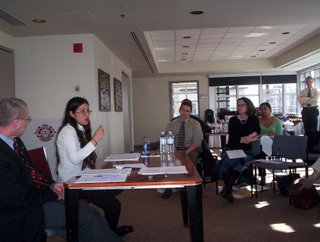
Annette Reed presents.
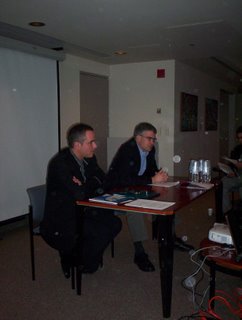
Craig Evans presents. Dominique Côté (l) chairs the session.
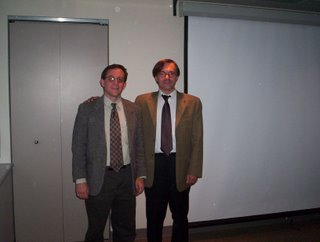
Davila and Piovanelli at the end of the workshop. Fortunately, the massive hayfever attack I suffered all weekend doesn't show here.
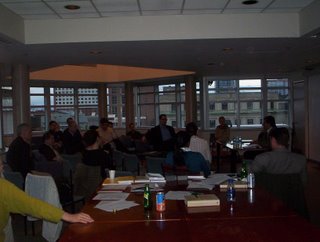
The final meeting of the workshop. This was an important session that may have reprecussions in the field for years to come. (Remember, Davila was there too! -- as usual, behind the camera.) There were preliminary discussions about the possibility of opening a new branch of the European association that focuses on Christian Apocrypha (AELAC -- Association pour l'étude de la littérature apocryphe chrétienne), and producing a new collection of New Testament Apocrypha in English and a collection of introductory essays on the NT Apocrypha. (I know that no one likes the term "New Testament Apocrypha" as a scholarly category, but, like Old Testament Pseudepigrapha, I use it here because it is useful as a shorthand, since people have some idea what it means.)
I have also added a photo [now also the abstract] of the Painchaud session to my post from Sunday.
Once again, this was an extremely successful and well-run conference and it was a privilege to be there. It was a excellent opportunity for English- and French-speaking specialists in the Christian Apocrypha from both sides of the Atlantic to get to know one another and one another's research. Many thanks to Pierluigi for all his hard work in hosting it.
Lorenzo DiTommaso
Concordia University
Jewish Pseudepigrapha and Christian Apocrypha:
Definitions, Boundaries, and Points of Contact
Only in the past few decades has the study of biblical apocrypha begun to transcend the balkanisation imposed on it for a variety of historical and theological reasons. Although certain distinctions among the categories remain important, it is now clear that they do not automatically warrant the rigid classification of the corpus of apocryphal literature on the basis of chronology, canon, or confession. This paper examines two of these historical categories, the Jewish Pseudepigrapha and the Christian Apocrypha, with the goal of identifying avenues and approaches by which current research on the first collection of texts might inform the study of the second. The paper focuses on the related issues of definitions, terminology, and boundaries, and on the confirmed and potential points of contact between the two collections.
Evans discussed the Gospel of Thomas, the (so-called) Gospel of Peter, Papyrus Egerton 2, and Secret Mark.Craig A. Evans
Acadia Divinity College
The Apocryphal Jesus:
Assessing the Possibilities and Problems
The debate surrounding the usefulness of the extracanonical Gospels for historical Jesus research is a long one, which in one form or another can be traced back to the early church. One thinks especially of second, third, and fourth-century Fathers who appeal to various Gospels or Gospel recensions in commentaries, treatises, and apologetic works, consciously supplementing, even modifying the tradition of the canonical Gospels. In some ways what these early Christian theologians and apologists were doing was not much different from the objectives and activities of the modern research. The present study undertakes a critical investigation of the status of the question today, advocating an openness to the possibility of early, reliable tradition in these texts, but at the same time urging greater caution in their use.
Michael Kaler
McMaster University
Gnostic Irony and the Adaptation of the Apocalyptic Genre
For gnostic authors as for other early Christians, Jewish and Christian apocalyptic writings were valued sources of information and inspiration. Apocalyptic works provided their readers with information about the true meaning of history, the nature of the cosmos, and humanity’s origins and destiny. The influence of apocalyptic works, and of the canons of the apocalyptic genre, on gnostic writings of all sorts is clear. But one of the fundamental elements of apocalyptic writings was a glorification of the creator-God, a divinity whose status gnostic works radically downgraded. The tension caused by this basic difference in attitudes towards the creator-God and his creation led to the ironic reappropriation of the norms of the apocalyptic genre on the part of some authors. In this paper, I will examine this reappropriation as manifested in the gnostic Apocalypse of Paul and the Apocalypse of Adam.
Here are a few of the many photographs I took. You can click on any of them to get a larger image.

Candid group photo taken on Saturday. The waiter pushed the button prematurely and also had his finger on the lens. Sorry everyone, but the other two were even worse. The baby in the front row is Katerina, daughter of Cornelia Horn and Rob Phenix. She was the quietest, most contemplative baby I've ever met.

Pierluigi Piovanelli (l) and Lorenzo DiTommaso (r) in the opening session.

Michael Kaler presents.

Annette Reed presents.

Craig Evans presents. Dominique Côté (l) chairs the session.

Davila and Piovanelli at the end of the workshop. Fortunately, the massive hayfever attack I suffered all weekend doesn't show here.

The final meeting of the workshop. This was an important session that may have reprecussions in the field for years to come. (Remember, Davila was there too! -- as usual, behind the camera.) There were preliminary discussions about the possibility of opening a new branch of the European association that focuses on Christian Apocrypha (AELAC -- Association pour l'étude de la littérature apocryphe chrétienne), and producing a new collection of New Testament Apocrypha in English and a collection of introductory essays on the NT Apocrypha. (I know that no one likes the term "New Testament Apocrypha" as a scholarly category, but, like Old Testament Pseudepigrapha, I use it here because it is useful as a shorthand, since people have some idea what it means.)
I have also added a photo [now also the abstract] of the Painchaud session to my post from Sunday.
Once again, this was an extremely successful and well-run conference and it was a privilege to be there. It was a excellent opportunity for English- and French-speaking specialists in the Christian Apocrypha from both sides of the Atlantic to get to know one another and one another's research. Many thanks to Pierluigi for all his hard work in hosting it.
Monday, October 02, 2006
BIBLICAL STUDIES CARNIVAL 10 has been posted by Phil Harland at his Religions of the Ancient Mediterranean blog.
THE WORKSHOP IS OVER and I head back to Scotland this afternoon. I took lots of photos and I'll post some, along with more commentary, once I can get my laptop networked again. But I'll just say now that the conference was very successful, especially in gathering together people in disparate but closely related fields (New Testament, NT Apocrypha, early Judaism, OT Pseudepigrapha, etc.) who rarely get the chance to talk to one another. I hope this leads to more communication both across those fields and across the Atlantic. And it sounds as though a big project or two might come out of this weekend as well.
Sunday, October 01, 2006
DEAD SEA SCROLLS LECTURE in Kansas City:
Curator of Upcoming Dead Sea Scrolls Exhibit to Speak at KU
Portions of the scrolls will be on display at Union Station in Kansas City starting Feb. 8.
Lawrence, Kan. - infoZine - Morris Margolies, curator of an upcoming exhibit at Kansas City's Union Station featuring ancient religious texts, will speak at the University of Kansas next month.
Margolies lecture, "Judaism and Christianity in the Dead Sea Scrolls," will be presented at 7:30 p.m. Wednesday, Oct. 11, in the Alderson Auditorium at the Kansas Union. Portions of the scrolls will be exhibited at Union Station, one of only four U.S. venues on a tour authorized by the Israel Antiquities Authority.
[...]
ST. JEROME'S FEAST DAY WAS YESTERDAY. The Catholic Encyclopedia writes:
Meant to post this yesterday, but circumstances did not permit.
St. Jerome owes his place in the history of exegetical studies chiefly to his revisions and translations of the Bible. Until about 391-2, he considered the Septuagint translation as inspired. But the progress of his Hebraistic studies and his intercourse with the rabbis made him give up that idea, and he recognized as inspired the original text only. It was about this period that he undertook the translation of the Old Testament from the Hebrew. But he went too far in his reaction against the ideas of his time, and is open to reproach for not having sufficiently appreciated the Septuagint. This latter version was made from a much older, and at times much purer, Hebrew text than the one in use at the end of the fourth century. Hence the necessity of taking the Septuagint into consideration in any attempt to restore the text of the Old Testament. With this exception we must admit the excellence of the translation made by St. Jerome.That's a pretty fair evaluation. The Dead Sea Scrolls show both that many variants in the Septuagint have a Hebrew basis and some are better readings than those of the Masoretic Text. At the same time, the Scrolls show that the Masoretic text has a very ancient basis and needs to be taken seriously.
Meant to post this yesterday, but circumstances did not permit.
I'M HERE -- IN OTTAWA. Got here Friday afternoon. (My luggage took a more leisurely route, but that`s another story.) The Internet access my room was supposed to have remains, alas, hopelessly glitched, and the conference has been very full (and very good), so this is the first chance I`ve had to take up Pierluigi's kind offer to use his office computer.
[UPDATE (2 NOVEMBER): Welcome, visitors from Biblical Studies Carnival XI! There's an earlier post on the conference that includes the full conference program and links to my conference paper and a related earlier paper.]
I`ve heard a great many good papers. So far the one that would be of most general interest was by Louis Painchaud, in which he argues (to condense his argument rather drastically) that in the recently published Coptic Gospel of Judas, Judas was actually a baddy, just as in the canonical gospels.
I'm here until tomorrow afternoon and hope to be able to fit in some more blogging between now and then. I have almost 70 e-mails in my inbox, so if you sent me a message, it may have to wait until I'm back home.
It's great to spend a weekend with a bunch of philology geeks who think it's normal to know and talk about Greek, Latin, Syriac, Coptic, Arabic, etc. and who understand the deep satisfaction that comes only from reconstructing the text of an ancient document from corrupt manuscripts and then deciphering what it says.
UPDATE (3 October): A photo of Louis Painchaud presenting his paper. Paul-Hubert Poirier, in the foreground, chaired the session. (Click on image for larger version.)
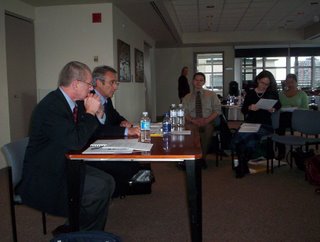
UPDATE (4 October): Professor Painchaud has kindly given me permission to post the English abstract of his paper:
[UPDATE (2 NOVEMBER): Welcome, visitors from Biblical Studies Carnival XI! There's an earlier post on the conference that includes the full conference program and links to my conference paper and a related earlier paper.]
I`ve heard a great many good papers. So far the one that would be of most general interest was by Louis Painchaud, in which he argues (to condense his argument rather drastically) that in the recently published Coptic Gospel of Judas, Judas was actually a baddy, just as in the canonical gospels.
I'm here until tomorrow afternoon and hope to be able to fit in some more blogging between now and then. I have almost 70 e-mails in my inbox, so if you sent me a message, it may have to wait until I'm back home.
It's great to spend a weekend with a bunch of philology geeks who think it's normal to know and talk about Greek, Latin, Syriac, Coptic, Arabic, etc. and who understand the deep satisfaction that comes only from reconstructing the text of an ancient document from corrupt manuscripts and then deciphering what it says.
UPDATE (3 October): A photo of Louis Painchaud presenting his paper. Paul-Hubert Poirier, in the foreground, chaired the session. (Click on image for larger version.)

UPDATE (4 October): Professor Painchaud has kindly given me permission to post the English abstract of his paper:
Christian Apocryphal Texts for the New Millennium.
Achievements, Prospects, and Challenges
Université d’Ottawa, 30 septembre et 1er octobre 2006
À PROPOS DE LA (RE)DÉCOUVERTE DE L’ÉVANGILE DE JUDAS
Abstract
by Louis Painchaud
Since its publication by the National Geographic Society last April, the Gospel of Judas has been interpreted and presented by the scholars in charge of its edition and translation as rehabilitating the figure of the apostle, who would be the true disciple of Jesus, the only one who understood his mission, to whom the spiritual Saviour would have asked to deliver him from his carnal body. This Judas would be a model of the perfect (gnostic) Christian.
A close reading of the Gospel of Judas reveals a totally different picture. Judas is guilty of sacrificing the man who wore Jesus, he is a demon, misled by his star, and he will never make it to the place reserved for the Holy Generation.
He is both demonized, in the same way as he is demonized in the Gospel of John, and assimilated to Juda the patriarch eponym of Judaism through the question “What advantage…? (GosJud 46:16; Gen 37:26). Like his homonym, he will inherit the government over the lower world, over the other apostles and the generations who will curse him (GosJud 46:23; Gen 49:10). The Judas of the Gospel of Judas is the very symbol of the betrayal of the name of Jesus through the interpretation of his death as a sacrifice in a proto-orthodox Christianity perpetuating the sacrificial cult of the Temple of Jerusalem.
Partly misled by the expectations raised by the reader of a Gnostic revelation dialogue concerning the main interlocutor of the Saviour, the scholars who presented the GosJud in such an erroneous way read into the text what we already knew from Ireneaus and Epiphanius instead of the text itself and saw in Judas the perfect disciple according to their opponents. This led to a reception of this new text perfectly in harmony with the expectations of the Western World in the second half of the 20th century, in need of a rehabilitated Judas in the context of the reappraisal of Jewish Christian relationships.
Subscribe to:
Comments (Atom)